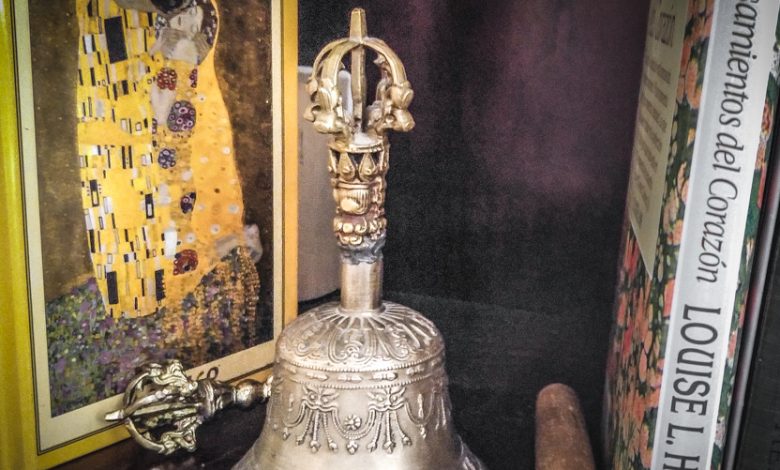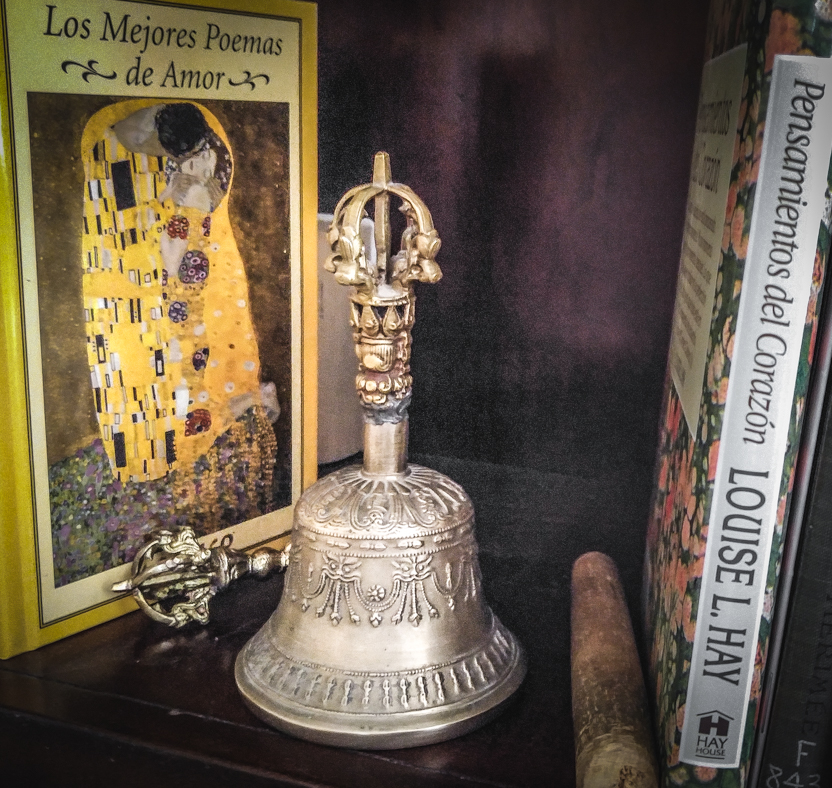A Bell that Connects Tibet, Buddhists and Peru

A bell to ring for the Pachamama. It was beautiful, shining in the sun, waiting to play its role in the rites. The sight of the bell didn’t just stand out against the rocks of Saqsayhuaman, but struck deep inside my past. I had received such a bell from my Aunt Kay when I was only a small child. She told me of her travels to the mountains of Tibet.
I studied the image and was surprised to see the same images formed on its sides. To me it is a Tibetan prayer bell, whose sound is used to carry prayers to heaven. Buddhist monks use the bells for prayer, healing meditation, ritual ceremonies and other sacred offerings. I was surprised to see it on the cloth, with other offerings to the Pachamama, but then began to think about the history of Peru and Japan and China.

In 1899, 790 Japanese men immigrated to Peru for work. They found conditions unfavorable, and adaptation to the predominately Catholic culture of the haciendas almost impossible. Reports vary about the number of people who died from various causes, some stating up to 79%, however this figure may be very high.
In the face of the ‘tragedy of the initial immigrants’ it was decided to send official delegations to Peru. The priests, the Revs. Ueno Matsumoto and Kinoshita received their calling to go to Peru as missionaries to help the immigrants and to teach Buddhism.
The work was difficult and a year after their arrival Kinoshita and Matsumoto were quoted in Jodokyoho, the institutional bulletin of the Jodo school (No 653, 1905) as saying, “People did not want to hear anything about religious topics nor did they have any interest in a good life based Buddhist education.” Rev. Kinoshita also said, “I could not do the mission work well because the emigrants work hard, for twelve hours in the sugar factory or ten hours on the farm, so they don’t have any free time. Sunday is their only opportunity to rest and go shopping. No one seriously listens to sermons…I think it still isn’t time to begin the mission in Peru because there are not many Japanese and only a few of them support us. For that reason, it is very difficult.” (http://global.sotozen-net.or.jp/pdf/dharma-eye/de12/de12_08.htm)

But Rev. Kinoshita and Matsumoto did not leave Peru. Instead they established the Japanese Club so people could socialize with others of their religious background. Missionaries continued to teach the people and encourage them in their learning about Buddhism. More immigrants arrived from Japan and the religion grew slowly. Peru and Brazil have the greatest numbers of Japanese living outside of Japan. There have also been significant numbers of Chinese immigrants to Peru.
According to Frank Usarski, Pontifícia Universidade Católica de São Paulo, Programa de Estudos Pós-Graduados em Ciências da Religião, “While the first decades of Buddhism were related to Asian immigration more recent trends gained momentum through a growing number of South Americans who – from the 1960’s onward parallel the development in other Western countries – discovered Buddhism as an alternative to their inherited religions.”
Interaction between the West and East continues. In 2006, the Dahli Lama made a trip to Cusco to meet with the Q’ero Lisa Garrigues claimed that “Among the cloud-covered peaks of the Peruvian Andes, local people speak of a “geographic shift” of the world’s spiritual center from the Himalayas to the Andes and of the increasing role of American indigenous traditions in rebalancing the earth.

Meeting in Korikancha, the Q’ero greeted the Dahli Lama in their traditional clothing and leader Issac Flores declared “We are Inca.” Another woman from the crowd asked of the Dahli lama, “I hear he’s supposed to be a spiritual leader. Does he know how to make offerings to the earth?”
The bell seems a symbolic joining of the nations in making an offering that echoes through the mountains of all the world and back to my own private bookshelf, deep in the heart of my home.
(http://indiancountrytodaymedianetwork.com/2006/05/31/dalai-lama-meets-incan-descendants-117758)
Politics of exporting Japan Toake Endoh




